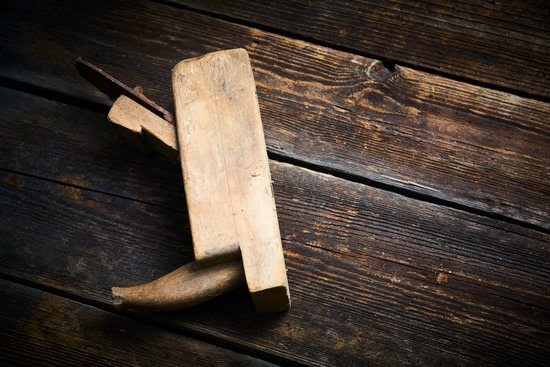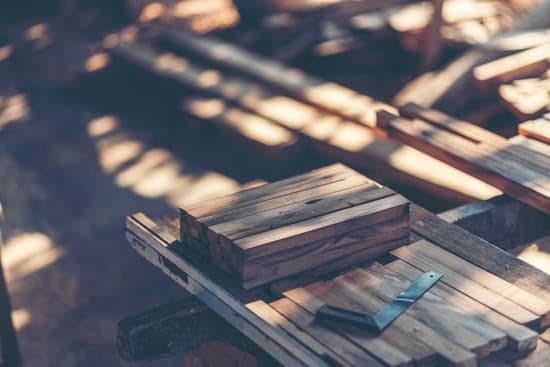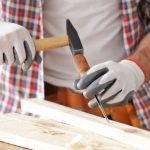Rough wood is a common starting point for many woodworking projects, but before it can be used, it must be squared. Squaring rough wood is a vital step in the woodworking process as it ensures the quality and structural integrity of the final piece. This article will guide you through the steps and techniques required to successfully square rough wood, resulting in precise measurements and smooth surfaces.
Understanding why rough wood needs to be squared is crucial in achieving successful woodworking projects. When wood is freshly cut or purchased from a lumberyard, it may have uneven edges, irregular surfaces, or natural flaws. Squaring the wood ensures that all sides are straight, perpendicular, and parallel to each other. By doing so, you create a solid foundation for your project and minimize any potential problems that may arise later on.
To effectively square rough wood, you will need specific tools and materials. These include hand planes or power tools such as jointers or planers for removing excess material; measuring tools like try squares, carpenter’s squares, and calipers for ensuring accuracy; clamps to hold the wood securely in place during the squaring process; and safety equipment like goggles and ear protection.
In the following sections of this article, we will provide a step-by-step guide on how to properly square rough wood for your woodworking projects. From selecting the right type of wood to fine-tuning the squaring process for precise results, we will cover all aspects of achieving squared perfection. Additionally, we will offer tips and tricks for efficient squaring techniques while troubleshooting common challenges that may arise during the process.
By mastering the art of squaring rough wood in woodworking projects, you unlock endless possibilities of creating high-quality pieces with both strength and aesthetic appeal. Stay tuned as we delve into each step in detail to transform your raw materials into beautifully squared building blocks of creativity.
What is Rough Wood and Why Does it Need to Be Squared for Woodworking Projects?
Rough Wood refers to the lumber that has been freshly cut from a tree and has not undergone any further processing or finishing. It is the initial form of wood that is used in woodworking projects. When lumber is sawn from the tree, it often has uneven, irregular edges and surfaces. This roughness can make it difficult to work with and result in imprecise and unstable woodworking projects.
There are several reasons why rough wood needs to be squared for woodworking projects:
1. Stability: Squaring rough wood ensures that the boards have straight edges and flat surfaces, making them stable and less prone to warping or twisting over time. This stability is crucial, especially if the wood will be used for constructing furniture or other structural pieces.
2. Joinery: Squaring rough wood is essential for creating strong and accurate joinery. Square edges and flat surfaces allow for precise joinery techniques such as dovetails, mortise and tenon joints, or dowel joints. Properly squared wood ensures tight-fitting connections that contribute to the overall strength and durability of the finished project.
3. Aesthetics: Squaring rough wood enhances the visual appeal of the final piece by creating clean lines and smooth surfaces. It allows for better grain matching when boards are joined together, resulting in a more pleasing overall appearance.
By taking the time to square rough wood before starting a woodworking project, you can ensure that your finished piece is not only visually appealing but also structurally sound and long-lasting. Squaring allows you to work with precision, confidence, and achieve professional-quality results in your woodworking endeavors.
Tools and Materials Required for Squaring Rough Wood in Woodworking
In order to successfully square rough wood for woodworking projects, it is essential to have the right tools and materials at your disposal. Having the proper equipment will not only make the process easier but also yield more precise results. Here are some of the key tools and materials required for squaring rough wood in woodworking:
Measuring Tools
Accurate measurements are crucial when squaring rough wood. A measuring tape or ruler is necessary for taking dimensions like length, width, and thickness. Additionally, a try square and a carpenter’s square are essential for checking right angles and assessing parallel surfaces respectively.
Cutting Tools
To remove excess material during the squaring process, cutting tools such as a hand saw or a circular saw may be needed. These tools allow you to trim and cut the wood to achieve the desired dimensions.
Smoothing Tools
Smoothing tools help refine the surface of the squared wood, ensuring it is flat and smooth. A hand plane or an electric planer can be used to level uneven surfaces, remove high spots or imperfections, and create a uniform thickness across the board.
Clamps
Clamps play a crucial role in securing the wood during the squaring process. They hold the rough wood firmly in place while you make cuts or use smoothing tools, preventing any movement that could result in inaccurate squaring.
Safety Equipment
Working with woodworking tools can be dangerous if safety precautions are not taken seriously. Essential safety equipment includes safety goggles or glasses to protect your eyes from flying debris, ear protection such as earmuffs or earplugs to prevent hearing damage from loud machinery, and gloves to protect your hands from sharp edges or splinters.
By having these necessary tools and materials on hand before beginning your project, you can ensure a smoother and more efficient squaring process. Remember to always prioritize safety by using appropriate safety equipment and following proper usage guidelines for each tool.
Step-by-Step Guide
Woodworkers understand the importance of squaring rough wood before beginning any woodworking project. Squaring rough wood is a crucial step that ensures the quality and structural integrity of the final product. In this step-by-step guide, we will walk you through the process of squaring rough wood for your woodworking projects.
**Step 1: Selecting the Right Wood and Preparing it for Squaring**.
Before you can square rough wood, it is essential to choose the right wood for your project. Look for straight and stable pieces that are free from major defects such as large knots or splits. Once you have selected your wood, prepare it by removing any loose bark or debris.
**Step 2: Assessing the Natural and Manufactured Flaws in the Wood**.
Next, carefully inspect the piece of wood for any natural flaws such as irregular shapes, warping, twisting, or bowing. Additionally, check for any manufactured flaws like saw marks or rough edges. Identifying these flaws early on will help you plan your squaring process more effectively.
**Step 3: Strategies for Achieving Initial Rough Squaring**.
To begin squaring rough wood, start by marking reference lines on each face of the board. Use a pencil or marking gauge to make straight lines that define the width and length of your desired square piece. These reference lines will act as a visual guide throughout the squaring process.
Once you have marked your reference lines, use a hand saw or circular saw to trim off excess material along one edge of the board. Make sure to cut just outside the line to allow for future adjustments if needed. Repeat this process on an adjacent edge of the board until two edges are parallel.
**Step 4: Fine-tuning the Squaring Process to Achieve Precise Results**.
After achieving initial rough squaring by establishing two parallel edges, it is time to fine-tune the process for precise results. Use a hand plane or power planer to remove excess material from the remaining two edges of the board. Work slowly and carefully, checking for any inconsistencies in thickness or width along the way.
Once all four edges have been squared and are parallel, check the diagonals of the board to ensure it is square. Measure the distance between opposite corners of the board using a tape measure or ruler. If the measurements are equal, then your wood is squared. However, if they are not equal, adjust one corner until both diagonal measurements match.
By following this step-by-step guide, you will be able to successfully square rough wood for your woodworking projects. Remember to work patiently and pay attention to detail throughout the process for accurate and precise results. In the next section, we will share some tips and tricks to help you efficiently square rough wood in woodworking.
Tips and Tricks for Efficiently Squaring Rough Wood in Woodworking
When it comes to squaring rough wood for woodworking projects, there are several tips and tricks that can help you achieve efficient and accurate results. These techniques can make the process smoother and more enjoyable, while ensuring that your finished pieces are of high quality. Here are some valuable tips to keep in mind:
Tip 1: Choosing the Most Suitable Squaring Technique for Different Wood Types
Different types of wood may require different squaring techniques. For example, softwoods like pine or cedar may be more easily squared with hand tools such as hand planes, while hardwoods like oak or walnut may benefit from the use of power tools like jointers or planers. Understanding the characteristics of the wood you are working with can guide you in selecting the most appropriate technique.
Tip 2: Utilizing Hand Planes and Power Tools for Smooth and Accurate Squaring
Hand planes are versatile tools that can be used to remove material and create flat surfaces on rough wood. They allow for precise control over shaping and smoothing, especially when working on small or intricate parts. Power tools such as jointers, planers, or table saws can also be valuable assets in squaring rough wood quickly and accurately.
Tip 3: Avoiding Common Mistakes and Pitfalls During the Squaring Process
There are common mistakes that can hinder your progress when squaring rough wood. One important tip is to start with a sharp blade or cutting tool to ensure clean cuts. It’s also essential to work patiently and take small passes when removing material, as rushing can lead to mistakes or uneven surfaces. Additionally, maintaining consistent pressure throughout the process helps prevent uneven removal of material.
Implementing these tips and tricks into your woodworking practice will enhance your ability to efficiently square rough wood. By choosing suitable techniques, utilizing the right tools, and avoiding common mistakes, you can achieve accurate and high-quality results in your woodworking projects.
| Squaring Technique | Wood Type |
|---|---|
| Hand Planes | Pine, Cedar |
| Power Tools | Oak, Walnut |
Ensuring Accuracy and Precision
Achieving accuracy and precision is essential when squaring rough wood for woodworking projects. Using the proper measuring tools can help verify that the wood has been squared correctly. There are several measuring methods that can be used to assess the squareness, parallelism, smoothness, and uniformity of the wood.
One commonly used tool for checking right angles is a try square. A try square consists of a steel blade and a handle at a 90-degree angle. To use a try square, simply place the handle against one edge of the wood and align the blade against another edge.
If the blade meets both edges perfectly without any gaps or overlaps, then the wood is squared at a right angle. This tool is particularly useful when ensuring corners are perpendicular in projects such as cabinets or frames.
Another handy tool for assessing parallel surfaces is a carpenter’s square. It consists of two legs joined together at a 90-degree angle, typically made of metal or plastic.
To use a carpenter’s square, place one leg against one surface of the wood and check if the other leg rests flush on another surface parallel to it. This tool ensures that two surfaces are parallel to each other, which is important for constructing boxes or furniture with multiple sides.
In addition to checking angles and parallelism, it is also crucial to verify smoothness and uniformity in squared wood. A caliper can be utilized for this purpose. A caliper measures thickness or width by placing its jaws on opposite sides of an object and displaying measurements on a scale or digital display. By taking multiple measurements along the length of squared wood, it’s possible to identify any discrepancies in thickness or width that need to be corrected.
Using these measuring tools in combination will help ensure that squared wood meets desired specifications in terms of accuracy, precision, squareness, parallelism, smoothness, and uniformity. Incorporating these measurement techniques into the woodworking process will lead to high-quality and structurally sound projects.
| Measuring Method | Purpose |
|---|---|
| Try Square | To check if the wood is squared at a right angle |
| Carpenter’s Square | To assess parallel surfaces of the wood |
| Caliper | To measure smoothness and uniformity in thickness or width of the wood |
Troubleshooting Common Challenges When Squaring Rough Wood in Woodworking
Challenge 1: Addressing Warping, Twisting, and Bowing in the Wood
One of the most common challenges woodworkers face when squaring rough wood is addressing warping, twisting, and bowing in the wood. These issues can result from the natural drying process of wood or improper storage conditions. However, they can be rectified with the right techniques.
To tackle warping, twisting, and bowing, it’s important to identify the direction in which these distortions occur. This can be done by observing how the board lays on a flat surface and noting any visible bends or curves. Once identified, you can employ various methods to correct these issues.
One effective technique is known as “jointer planing.” Using a jointer planer or a hand plane, you can remove small amounts of material from the high spots of the curved surface until it becomes more even. It’s crucial to work gradually and make light passes to avoid removing too much material. Additionally, clamping your wood to a flat surface overnight can also help alleviate warping.
Challenge 2: Tackling Complex Grain Patterns and Knots During Squaring
Complex grain patterns and knots are another challenge that arises when squaring rough wood for woodworking projects. These irregularities can cause tear-out, where chunks of wood are forcibly removed during planing or shaving processes due to changes in grain direction.
To prevent tear-out while squaring rough wood with complex grain patterns and knots, it’s important to carefully assess the direction of the grain before making any cuts or passes with tools. By studying the wood closely, you can determine which direction will minimize tear-out.
In some cases where tear-out cannot be avoided entirely due to particularly difficult sections of wood, you may have to resort to using specialized blades or cutters that are designed for minimizing tear-out. These tools typically feature high tooth counts or special blade geometry that helps cut through difficult grain patterns more smoothly.
Challenge 3: Correcting Inconsistencies in Thickness and Width
When squaring rough wood, inconsistencies in thickness and width can pose a challenge, especially if you desire precise and uniform dimensions for your woodworking project. These inconsistencies may occur due to variations in the growth pattern of the tree or unevenly milled surfaces.
To address inconsistencies in thickness, it’s important to use measuring tools such as calipers to determine the thickest and thinnest parts of the wood. Once identified, you can employ techniques such as planing or sanding to achieve a consistent thickness throughout the board.
Inconsistencies in width can be corrected by using a jointer plane or power tools like a table saw. By making careful passes and removing small amounts of material at a time, you can gradually trim down the excess width until you achieve the desired measurements.
By employing these techniques to address common challenges when squaring rough wood in woodworking projects, you can ensure that your final product is of high quality and meets your specifications. Remember to take your time, work methodically, and make adjustments as needed to achieve optimal results.
Importance of Squaring Rough Wood
Understanding the Importance of Squaring Rough Wood
In woodworking, the process of squaring rough wood is crucial for achieving high-quality results and ensuring the structural integrity of the finished project. When wood is originally harvested, it contains natural variations and imperfections such as warping, twisting, and irregular widths and thicknesses. These flaws not only compromise the aesthetic appeal of the wood but also negatively impact its strength and stability.
By taking the time to square rough wood, woodworkers can overcome these challenges and create pieces that are visually appealing, durable, and functional. Squaring involves carefully shaping each surface of the wood to be properly aligned with a reference edge or face. This ensures that all four sides of the board are flat, straight, and at right angles to one another.
Enhancing Quality through Squaring Rough Wood
Squaring rough wood significantly contributes to the overall quality of woodworking projects. When all sides of a piece of lumber are squared, it allows for seamless joinery between multiple boards. This is essential for creating strong connections in furniture construction or cabinetry where joints need to fit snugly together.
Additionally, squared rough wood provides a sturdy foundation for other woodworking processes such as cutting accurate dimensions and profiles. When working with properly squared pieces, measurements remain consistent throughout the project, leading to precise cuts and smooth assembly.
Improving Structural Integrity
Another key benefit of squaring rough wood is enhancing the structural integrity of woodworking projects. By squaring each side, any potential weaknesses or vulnerabilities in the board are identified and addressed before construction begins.
When working with twisted or warped pieces of wood, one side may be higher than others when placed on a flat surface. By carefully removing material from these uneven areas during squaring, woodworkers ensure that their final project will be stable and free from unwanted movement caused by internal stresses within the piece of wood. This is particularly important in projects that bear weight or have load-bearing requirements, such as tables, chairs, or shelving.
Overall, squaring rough wood is a critical step in woodworking that cannot be overlooked. It not only enhances the quality and appearance of the finished project but also guarantees its durability and stability over time. By taking the time to properly square each board, woodworkers lay the foundation for successful woodworking projects and unlock endless possibilities for their craftsmanship.
Additional Finishing Steps
After successfully squaring rough wood for woodworking projects, there are additional finishing steps that can be taken to enhance the quality and overall appearance of the wood. These steps include sanding, sealing, and treating the squared wood.
Firstly, sanding is a crucial step in ensuring a smooth and polished finish on the squared wood. Using sandpaper with varying grits, start with a coarse grit to remove any remaining roughness or imperfections on the surface. Gradually work your way up to finer grits to achieve a silky-smooth finish. Sanding not only creates a visually appealing surface but also prepares the wood for any necessary staining or painting.
Once the wood has been sanded, it is important to seal it to protect it from moisture and environmental damage. There are various sealing options available such as oil-based sealers, polyurethane, or varnish. Apply the chosen sealer evenly using a brush or rag, following the manufacturer’s instructions. This will add an extra layer of protection and enhance the natural beauty of the squared wood.
Additionally, treating the squared wood can further improve its durability and longevity. Wood treatments such as wood preservatives and insecticides help prevent rotting, warping, and pest infestation. Prioritize choosing treatments that are specifically designed for your type of wood and woodworking project. Apply these treatments according to their instructions to effectively safeguard your squared wood.
By incorporating these additional finishing steps of sanding, sealing, and treating your squared wood in woodworking projects, you can achieve optimal results in terms of both aesthetics and functionality. These steps contribute to enhancing the quality and structural integrity of your finished products while also protecting them from potential damage over time.
Conclusion
In conclusion, squaring rough wood is a fundamental skill that every woodworker should master. By understanding the importance of this process, selecting the right wood, and utilizing the appropriate tools and techniques, you can achieve precise results and enhance the quality and structural integrity of your woodworking projects.
Throughout this article, we have discussed step-by-step instructions on how to square rough wood, from selecting the right wood to fine-tuning the squaring process. We have also provided handy tips and tricks for efficient squaring, as well as troubleshooting common challenges that may arise.
By ensuring accuracy and precision through the use of measuring tools, such as try squares, carpenter’s squares, and calipers, you can verify that your squared wood meets the necessary requirements for your woodworking projects.
Squaring rough wood not only enhances the appearance of your projects but also plays a crucial role in their durability and longevity. With squared wood as a solid foundation, you can confidently move on to additional finishing steps such as sanding, sealing, and treating to achieve optimal results.
In conclusion, mastering the art of squaring rough wood in woodworking opens up endless possibilities for creativity and craftsmanship. By acquiring knowledge about this essential technique and practicing it diligently, you will be able to create high-quality pieces that showcase your skills while standing the test of time. So go ahead and unlock your potential by honing your squaring skills – you’ll be amazed at what you can achieve.

Hi everyone! I’m a woodworker and blogger, and this is my woodworking blog. In my blog, I share tips and tricks for woodworkers of all skill levels, as well as project ideas that you can try yourself.





